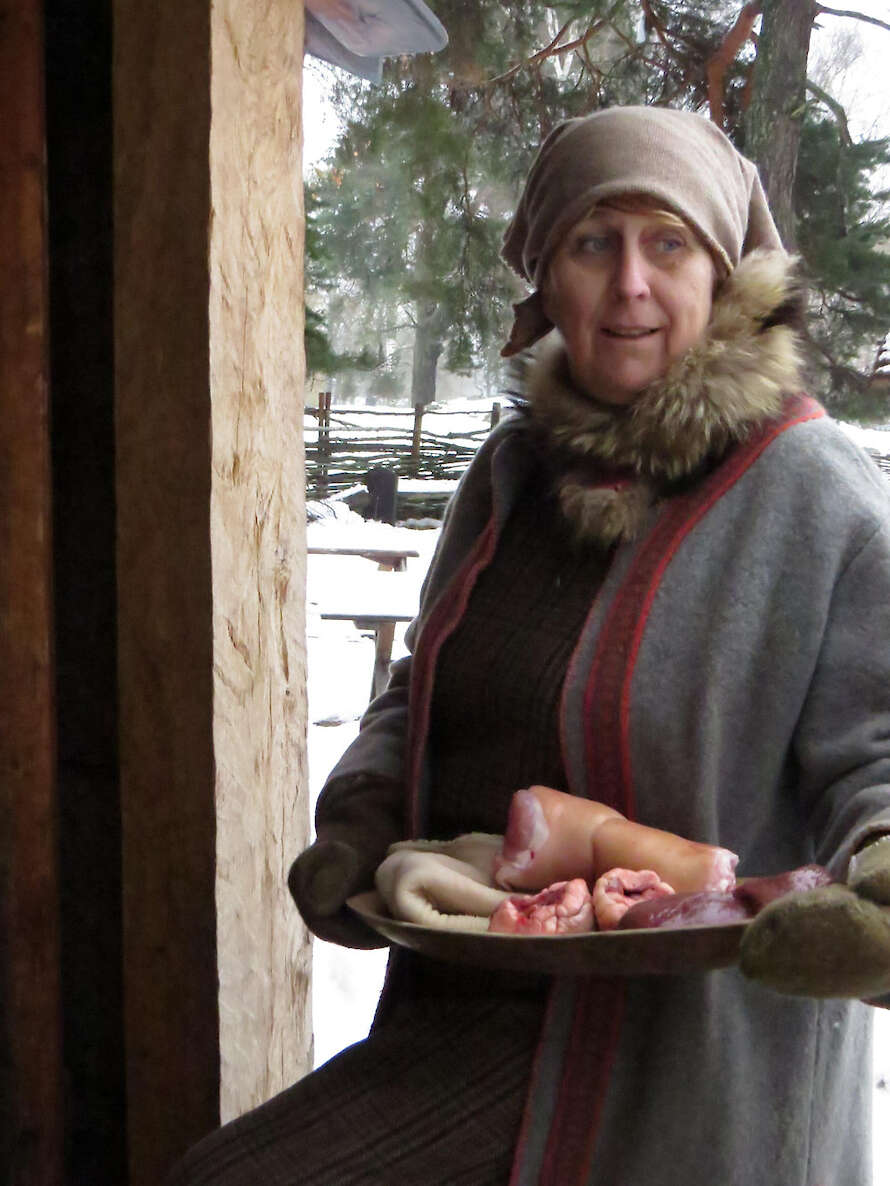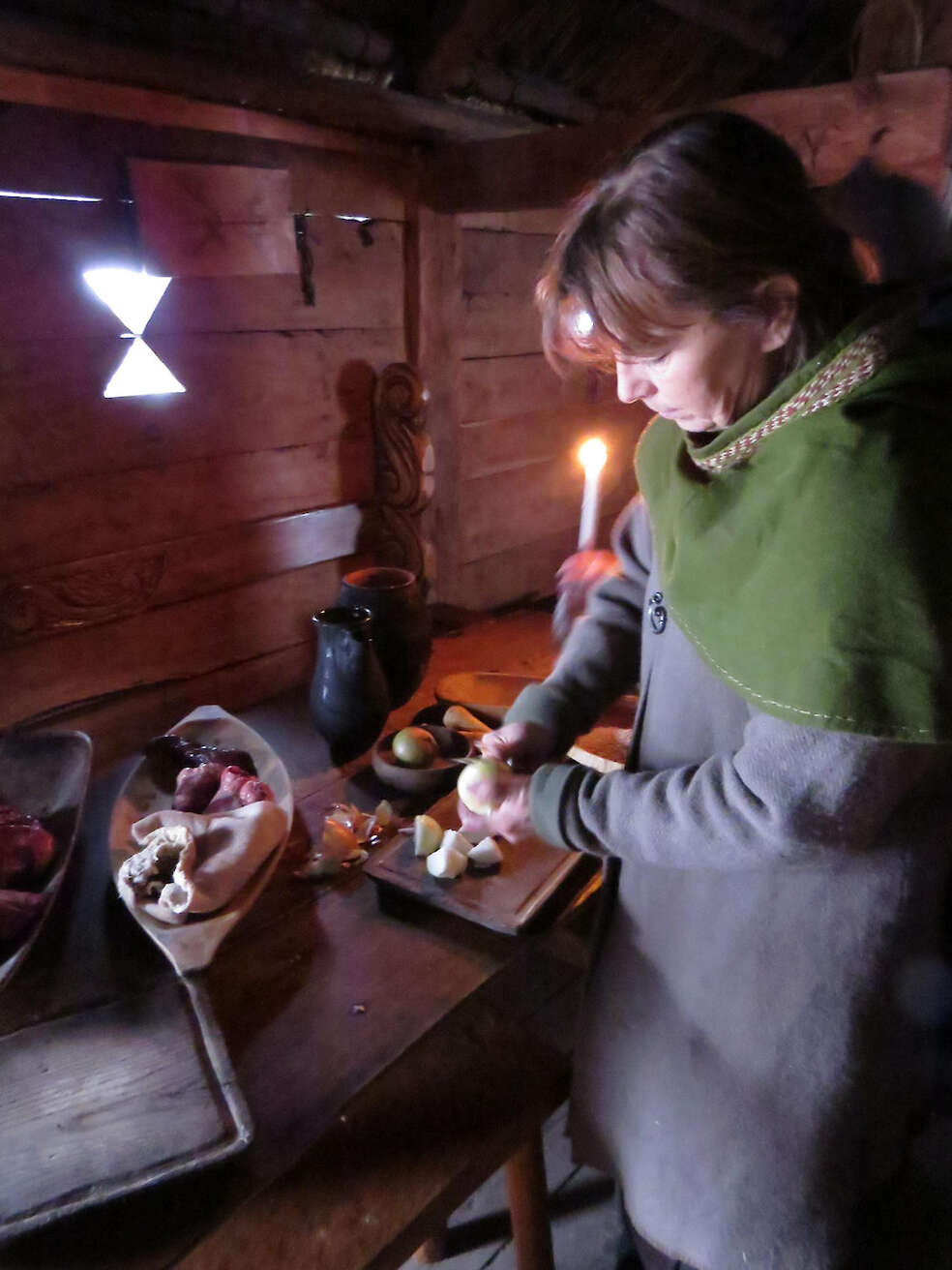In Scotland and around the world the 25th of January celebrates the life and poetry of the famous Scottish poet Robert Burns. Burns Night (Scots: Burns Nicht) suppers are traditionally accompanied with Scotland’s national dish ‘Haggis’.
You may ask yourself what does this have to do with the Vikings? Well the word Haggis actually derives from the Norse word ‘Baggi’ meaning bag or parcel. The dish may have been brought over to Scotland by the Vikings who colonised Orkney, Shetland and large parts of the North and West. Indeed it is almost identical to the Scandinavian dish ‘Lungmos’ – except there is more barley in the haggis. With this in mind we contacted the Viking age farmstead of Gunnes gård in Sweden and asked them if they could create a ‘Baggi’ dish in the way our ancestors may have done over a millennium ago.
Not just another day at the farm.
By Gun Bjurberg
Today is not just any day. Finally the late fall is here and the slaughter is all done. Fine salted hams are now hanging, drying and slowly smoked over the fire. Bowels are turned inside out and washed for sausage making. Every little piece of the sheep is taken care of. We’re making flutes from the leg-bones later this winter you know. And what’s more, the neighbouring farm even slaughtered a cow the other day and we traded some grain with them to get a piece of it.
But all that’s not for eating now. O no, we’ll have to wait for Yule for that and most of it is going to be stored so we make it through the winter. But we do have the next best thing, an abundance of offal. It’s the perfect time for one of our favourite dishes ‘Lungmos’ which literally translates into mashed lunges. You might have heard it being called Pölsa as well. This dish would certainly have been carried around by the Vikings in a sheep or deer stomach lining, much like Haggis.
Making the Lungmos ‘Baggi’
Early in the morning we started a fire in the kitchen house. It’s not every day that we use that house during the cold and dark winter, but for a big day like this we need the space and the utensils of the full kitchen. On the wooden worktop are the cow lungs, stomach and liver, sheep heart, pigs feett and salted leg, leftovers from a hunted rain deer, and some scrap meat from the slaughter. We also have barley, onions and parsnips. For seasoning we have some thyme from the garden and juniper berries from the forest around the farm.
Now here’s a tip for all of you when you are preparing lungs. It’s easier to cut the lungs if you first give them a short boil. Just make sure you keep them submerged as they tend to float when the bubbles in them expand. After the short boil, trim away the windpipe and cut it into smaller pieces.
Trim the fat and the membranes from the liver and cut it into pieces. With the rest of the meat and the cow stomach, just cut it into smaller pieces to cut down on the cooking time. I don’t want to chop any more wood than necessary, do you?
 It’s time for the vegetables. Finely chopped parsnips and onions give you a good broth to cook the meat in. Put the meat in and make sure to have the pot boiling. Now is the time to chop some more wood if you didn’t do it this morning, because this is going to take a while (or just have a snow ball fight as we did).
It’s time for the vegetables. Finely chopped parsnips and onions give you a good broth to cook the meat in. Put the meat in and make sure to have the pot boiling. Now is the time to chop some more wood if you didn’t do it this morning, because this is going to take a while (or just have a snow ball fight as we did).
When you have a nice pile of finely chopped wood, the meat should be cooked. Use the meat hook to take out all the nice pieces of meat. Scrape the last of the reindeer from the bone and cut all the rest of the meat as finely as you can.
In the mean time you can start boiling the barley. Make sure to season the broth with the Thyme and the crushed Juniper berries and then pour the barley in the big pot. If you are wealthy and did not use all the salt on preserving meats, then go ahead, use some now. Just don’t overdo it just because you can!
When the barley is cooked into a thick porridge, add the finely chopped meat again and it is done! Fill a big bowl and call in your family and friends, it’s time to eat. Did you bring your spoon? Take the leftovers if there are any, wait for it to cool down and then put it in the sheep or deer stomach lining. Now your ‘Baggi’ is ready to take with you on a voyage of discovery and adventure.
A big thank you!!! To Tona, Eir and Grim (aka Gun, Anna-Cari and Anders) from Vikingagården Gunnes gård farmstead, Upplands Väsby community, Sweden for recreating this delicious Viking age recipe.
Ingredients
- 1 x cow’s lung
- 1 x liver from a calf
- 2 x lamb’s hearts
- 2 x pig’s feet/trotters, 1 salted pig leg
- 1 x piece of cow stomach, as much meat you can spare
- 5 x onions
- 5 x parsnips
- 2 x bushels of barley
- 10 x juniper berries and a bundle of thyme
- 1 x sheep or deer’s stomach lining

